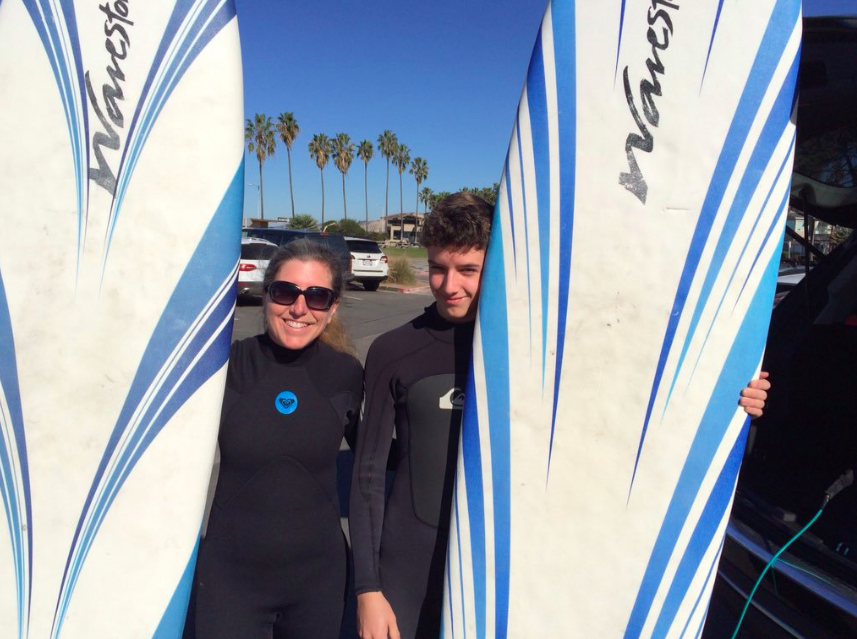
A ‘five x five’ presentation (five slides in five minutes) on emerging trends and surprising disruptions facing nonprofit leaders by Atkinson’s Executive Director Colette Murphy at the Ontario Nonprofit Network Connector Salon on Thursday, March 21, 2018 in Toronto. She’s pictured here with her son Malachy.
Let me begin with my conclusion. I believe the nonprofit sector is better equipped to handle emergence and disruptions than other sectors. We’re resourceful and centred on people not profit. We know how to engage new realities, adapt, and get organized to take care of each other in all weather conditions.
Given technological disruption, polarizing politics and rising inequality, many are predicting a bleak future for workers. Nonprofit leaders can swing daily between corrosive cynicism and irrelevant idealism. But most are holding the middle ground between the world that is and the world that could or should be. From my vantage point at Atkinson, I see signs of progress and hope.
Nonprofit leaders are in the business of raising expectations.
After all, it’s the nonprofit sector’s responsibility to help people see and enact their visions for themselves, their communities and their country. We’re all in the business of raising expectations. We’re not trying to predict what kind of work will be done in the future but we are working hard to make sure it will be decent. Thanks to ONN and others, we have started talking about the possibility of decent work instead of the inevitability of precarious work. The result is that we’re having a very different conversation than we were five years ago about funding, evaluation, and accountability. Conversation about the future of work begins with concern for the future of workers.
It’s been said that action doesn’t spring from thought, but from a readiness for responsibility. I’m encouraged by the trend that more nonprofits are ready to advocate again after a long, chilly winter.
Nonprofits are in a spring advocacy thaw and a violent media storm.
We’re taking responsibility — in a nonpartisan way — for renewing democratic institutions, shaping public policy, and making public services more effective. Many of us are advocating for workers and much more. Did you see this tweet on ONN’s feed yesterday? “We advocate for #decentwork because with healthier, happier, and better-supported workers, nonprofits can better meet their mission and deliver their programs and services.” Let’s all log on now and retweet it!
Dramatic disruptions in the media industry have, however, irreversibly altered how we advocate. A democratic society depends on a free press but no one knows who’s going to pay for it or how it will look in the future. No one can say how journalists will make a living, how their work will be structured or how their professional standards will be upheld. That uncertainty will have a big impact on nonprofit advocacy and communications strategies going forward.
Democracy is not the only fundamental system up for debate and renewal today. And the news media is not the only industry in transition. Technology is rewiring everything. I see nonprofit leaders making sure citizens have a say in shaping the future, especially the future of their work.
Nonprofit leaders are mobilizing citizens to generate power.
Nonprofit leaders operate in close proximity to people and earn their trust everyday. Many of you provide services as the first rung on a ladder to connect private troubles (like temporary work) to public issues (like antiquated employment standards.) By making this connection, citizens are building the grassroots power necessary to participate in making decisions that affect them.
But the disappearance of boundaries has changed many of the rules we played by in the past. I’m talking about the boundaries that used to delineate sectors but also geography and fields.
Boundaries are disappearing.
Nonprofits are starting enterprises at the same time as enterprises are becoming nonprofits. Local efforts can go global in an instant. The loss of boundaries have sweeping implications for the management of unionized and non-unionized workplaces. While the nonprofit labour force is growing in some areas, its shrinking in others and producing uneven job quality. New boundaries have to be redrawn regularly. There is no end to the job churn in sight.
While transition times are disorienting times, nonprofit leaders are agile and more likely to be found in deep water instead of shouting instructions from the shore.
Nonprofit leaders are learning to ride the waves
More than ever, leadership is about entering into the fast-moving currents of complex issues. It’s about staying close to the people most directly affected and who have enormous power to affect change when organized. It’s about advancing principles that keep people and their communities at the centre of our national vision for the future of work. The emergence of AI, for example, must be no more important than renewing EI.
At Atkinson, we’re not worried about the robots eating our jobs. We’re worried about them eating our communities. Work is a source of dignity as well as belonging. If work is a privilege enjoyed by a small percentage of us in the future and everyone else lives on an income provided by our benevolence, then we will have failed our mission as a sector. But if we ride the waves of change with confidence in each other and our shared purpose, all of us will ultimately know the satisfaction of a job well done.
